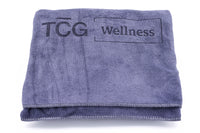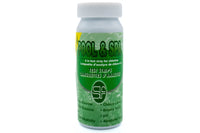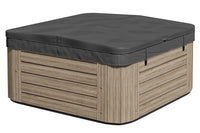The summer is winding down, with its backyard outings, crisp evenings and cool nights. Understandably, you want to spend as much time as possible in your hot tub. But there’s a difference between getting lots of use from your hot tub and overusing it in a single sitting.
First and foremost, we want you to have a safe and comfortable hot tub experience. That starts with understanding some ideal recommended guidelines and limitations for hot tub usage based on numerous factors.
As experts on all things hot tubs—from custom covers to filters, maintenance chemicals to aromatherapy—we here at The Cover Guy have read our fair share of the science and recommendations around hot tub usage. This article explores those findings in an easy-to-comprehend way, including some light scientific talk, and generally agreed-upon usage guidelines.
But right at the top here, please note: No internet article should stand in the place of a) your doctor’s recommendations, or b) your personal experience in the tub. If your doctor tells you to limit your soaks to x number of minutes, follow that advice. Likewise, if your body’s telling you something feels not quite right, step out of the tub, even if you’re well within the recommended duration.
Heat, Buoyancy, and Hydrostatic Pressure: The Science Behind Soaking
Before we delve into some recommended durations, we need to discuss what exactly a hot tub does, biologically speaking. And to understand that, we need should cover three basic mechanisms:
- Heat: This is the obvious one! It involves the transfer of thermal energy between yourself and the water, which increases your body temperature and relaxes muscles.
- Buoyancy: You know that feeling of “weightlessness” in the hot tub? That’s buoyancy. It is the upward force exerted by water, which reduces the body’s weight and relieves stress on joints.
- Hydrostatic Pressure: Unlike buoyancy, hydrostatic pressure is the downward pressure exerted by water on the body, which improves circulation and reduces swelling.
Together, these mechanisms work like a dream team—in moderation. While one pinpoints your muscles, another targets joints. While one generates endorphin production (the “feel-good” hormone), another dilates blood vessels. Acting in concert, they carry several health benefits, like:
- Pain relief
- Lowered blood pressure
- Muscle relaxation and muscle recovery
- Increased blood circulation
- And more restful sleep
However, like all good things, you can overdo it. These benefits peak at a certain point, after which time you may experience unwanted or harmful effects.
Too Much of a Good Thing? When the Benefits Outwear Their Welcome
What do massages, high-intensity exercises, sleep, and hot-tubbing have in common? They’re all roundly beneficial for your health. But they each present diminishing returns when you do them for too long. Eight hours of sleep is restful; 12 hours can leave you feeling even groggier than before. A half-hour of cardio is a health super-boost; four hours of cardio, and your body starts to show signs of wear and tear.
The same is true for spending time in a hot tub. What happens if you stay in a hot tub for too long? As mentioned, those basic mechanisms (heat, buoyancy, hydrostatic pressure) work all sorts of wonders in the short term. However, the heat, in particular, outwears its welcome after a while.
A predetermined duration in a hot environment is relaxing, both physically and mentally. However, as anyone who lives in the Florida Keys or Palm Springs will tell you, it’s essential to find respite after a while to avoid heatstroke. Prolonged exposure to heat can be dehydrating, and lowering blood pressure (which was so beneficial in the short-term) can reach too low a level, causing dizziness.
How Long Can You Stay in a Hot Tub? The Standards for Hot Tub Time
Everybody is different and every body is different. Still, authoritative medical organizations give standard guidelines for hot tub duration. They reach these figures through close research and a whole lot of averaging. Here are a few respected opinions to consider:
- Cleveland Clinic says to “Cap your hot tub time at 15 minutes — or shorter if you start to feel woozy or dehydrated.”
- The CDC doesn’t really weigh in. However, a document from the 80s of suggested guidelines for public hot tubs encourages people to “Observe reasonable time limits (that is, 10-15 minutes), then leave the water and cool down before returning for another brief stay.”
- Healthline, pulling research from numerous health authorities, agrees with the sentiment above. They suggest you "set your limit at 10 to 15 minutes.”
- Several online resources concerning how long should you stay in a hot tub for muscle recovery recommend 15 to 20 minutes.
We've seen some resources go as low as just suggesting 10, and others go as high as 20. But the general consensus—the “short answer” to the question posed in the title of this article—is around 15.

In-/Out Privileges: Doing Multiple Dips
Hold on just a second! Before you go toweling off, putting your custom Cover Guy cover back on the tub, and heading inside, remember that these are guidelines for a single session.
As multiple sources point out, you can do multiple dips, provided you cool down in between. Essentially, all you need to do is allow your body to “thermoregulate,” a fancy term for letting your body temperature re-reach its equilibrium.
There’s no set amount of time you must wait for this to happen. Just listen to your body. When you feel that your body temperature has cooled off sufficiently, you’re probably ready to head back in.
How to Limit Your Time in a Hot Tub
Especially if you’re hosting others, it’s best practice to encourage and track time limits. Even if it’s just you in the tub, it can be beneficial. And there are numerous things you can do to set your duration:
- Keep a clock or timer nearby, and set it when you enter the tub.
- Alternatively, just yell “Hey Siri!” (or the equivalent on your phone) and tell your digital assistant to set a timer for your preferred duration.
- Keep lounge chairs, good books, games, and other fun, restful activities near the hot tub so that cooling off is a pleasure in itself.
- Keep some water or other hydrating drinks nearby to replenish your hydration.
- Consider mounting a sign with “tub rules.” These can be mostly tongue-in-cheek, but they can also include important stuff like recommended durations.
By following these steps, you ensure that you and your guests enjoy a relaxing, beneficial round of hot tub soaks. When you’re done for the day, don’t forget to keep your hot tub protected with a high-quality cover.
The Importance of Setting the Right Temperature and pH
Time guidelines are only one half of the equation. What’s equally important is dialing in the recommended temperature and pH level.
Most guidelines, like the ones we posted above, recommend a temperature between 100 and 104 degrees Fahrenheit. That's in line with our recommended optimal temperature, according to various hot tub manufacturers. It’s hot enough to glean the benefits of hydrotherapy, but not so hot that it’s uncomfortable. Certain people, like children or those with heart conditions, should avoid the higher end of that temperature range.
You can dial in the temperature before you get in using a solar-powered digital thermometer. To retain heat, ensuring lower operating costs, we recommend combining a hard cover with a floating soft cover.
Also, to avoid discomfort when using your hot tub often, it’s necessary to balance your hot tub’s pH. When using a chlorine-based sanitizer, we recommend a pH between 7.0 and 7.6. When filling your hot tub with hard water, aim for a pH of 7.0 to 7.4. At The Cover Guy, we offer several straightforward products for dialing in the ideal pH.
Exceptions to the Rule
Here’s where we reveal that the question, “How long should you stay in a hot tub,” doesn’t really have a firm, universal answer. It's all dependent on your physiology.
In particular, pregnant people and people with blood pressure or heart conditions shouldn’t follow a pre-set guideline. Instead, talk to your healthcare provider. They know you better than any online article. They will tell you how much time—if any—it’s safe to soak in a hot tub, and what temperature to aim for.
What about the young ones? How long can kids stay in a hot tub? Several resources recommend capping the time for kids at around five minutes per session, or slightly longer at lower temperatures. That said, it’s best to run it past your family doctor or pediatric healthcare provider before taking the plunge.
As summer slowly turns into fall, you’ll be using your hot tub quite often. Keep the above recommendations in mind to enjoy a therapeutic, relaxing soak (and check out our hot tub fragrances to kick that relaxation into high gear). When in doubt, check with a healthcare provider for a more personalized guideline.









